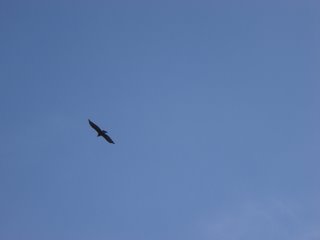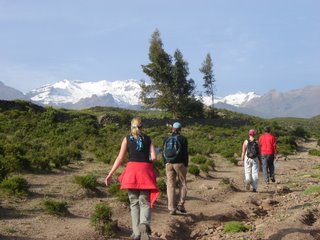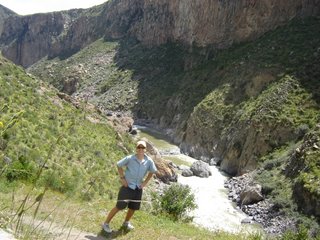Hualca Hualca
Some history of that volcano I tried to climb - though some of it may not be true, and other parts may have been confused by my still imperfect Spanish....
A man I met recently told me that as recently as the 1600s or 1700s there were sacrifices of young women on Hualca Hualca, in the same style as Juanita, the famous mummified sacrifice found on top of Ampato. He could remember stories of these activities being passed down - even when the Spanish were well established here. A young girl would be adorned with a sash onto which were pinned food and other offerings. The whole community would go with her to the volcano where she would pass through a window or gate and it was there that the sacrifice would be made - I think by putting the girl, alive, in a sacrificial tomb, but I am not sure. Because of landslides and earthquakes, the window no longer stands, though a friend of this man was hiking on the mountain and said he saw pieces of fabric and other artifacts. These frightened him immensely and he didn't return to investigate, though it was likely the spot of the "window" where mummies could be found. The term mummies is also a bit misleading, for the sacrificed are not preserved intentionally, but are preserved from the intense sun, dry air, and high altitude.
Hualca Hualca and Ampato, the next volcano over and a little higher in elevation were also once in a fight. The nature of the dispute was unclear to me, but I think that it had something to do with the sun's rays (which would make sense, given the importance of the sun to the Inca). The two volcanoes became so mad at each other that they began to fight. In the traditional manner of Incan warfare a stone with a string around it was flung at an opponent. It was in this way that the volcanoes fought, launching rocks at each other (something easy to imagine from active volcanoes). Today you can see a giant rock in the side of Hualca Hualca that Ampato launched and likewise one in the side of Ampato from Hualca Hualca. In the end, Hualca Hualca won the battle, and launched a rock that cut off the head of Ampato, which is why today you can see that Hualca Hualca rises to one singular point, while Ampato has a broad flat top, as if it is missing its head. Ampato also gets its name from its flat, squat appearance, which resembles a frog - the word for which in some local language is Ampato.
Finally, the Colca valley, before the Incas conquered it, was home to two distinct ethnic groups, the Collaguas and the Cabanas. The Collaguas lived in the high central part of the valley and practiced head deformation into taller shapes. The Cabanas occupied the lower part of the valley and practiced head deformation into wide and flat shapes. It is said that you can still see this reflected in the shapes of the hats that people wear. The capital for the Cabanas was Cabana which sits at the foot of Hualca Hualca. They also believed that they had come directly from the high snowy peaks of Hualca Hualca.
A man I met recently told me that as recently as the 1600s or 1700s there were sacrifices of young women on Hualca Hualca, in the same style as Juanita, the famous mummified sacrifice found on top of Ampato. He could remember stories of these activities being passed down - even when the Spanish were well established here. A young girl would be adorned with a sash onto which were pinned food and other offerings. The whole community would go with her to the volcano where she would pass through a window or gate and it was there that the sacrifice would be made - I think by putting the girl, alive, in a sacrificial tomb, but I am not sure. Because of landslides and earthquakes, the window no longer stands, though a friend of this man was hiking on the mountain and said he saw pieces of fabric and other artifacts. These frightened him immensely and he didn't return to investigate, though it was likely the spot of the "window" where mummies could be found. The term mummies is also a bit misleading, for the sacrificed are not preserved intentionally, but are preserved from the intense sun, dry air, and high altitude.
Hualca Hualca and Ampato, the next volcano over and a little higher in elevation were also once in a fight. The nature of the dispute was unclear to me, but I think that it had something to do with the sun's rays (which would make sense, given the importance of the sun to the Inca). The two volcanoes became so mad at each other that they began to fight. In the traditional manner of Incan warfare a stone with a string around it was flung at an opponent. It was in this way that the volcanoes fought, launching rocks at each other (something easy to imagine from active volcanoes). Today you can see a giant rock in the side of Hualca Hualca that Ampato launched and likewise one in the side of Ampato from Hualca Hualca. In the end, Hualca Hualca won the battle, and launched a rock that cut off the head of Ampato, which is why today you can see that Hualca Hualca rises to one singular point, while Ampato has a broad flat top, as if it is missing its head. Ampato also gets its name from its flat, squat appearance, which resembles a frog - the word for which in some local language is Ampato.
Finally, the Colca valley, before the Incas conquered it, was home to two distinct ethnic groups, the Collaguas and the Cabanas. The Collaguas lived in the high central part of the valley and practiced head deformation into taller shapes. The Cabanas occupied the lower part of the valley and practiced head deformation into wide and flat shapes. It is said that you can still see this reflected in the shapes of the hats that people wear. The capital for the Cabanas was Cabana which sits at the foot of Hualca Hualca. They also believed that they had come directly from the high snowy peaks of Hualca Hualca.







